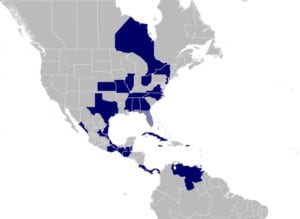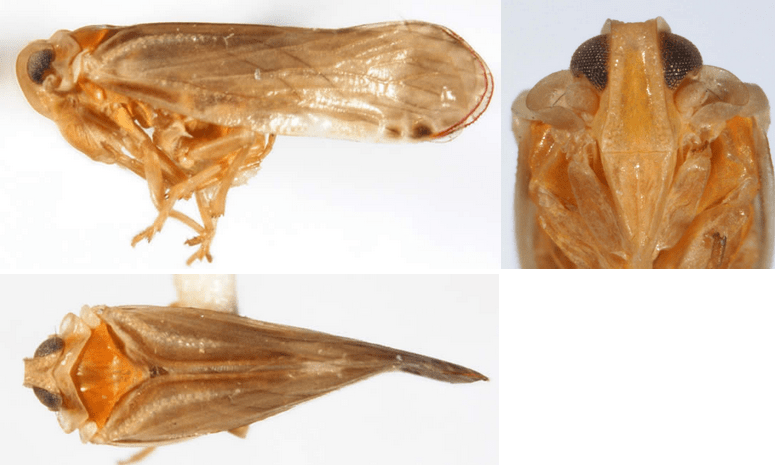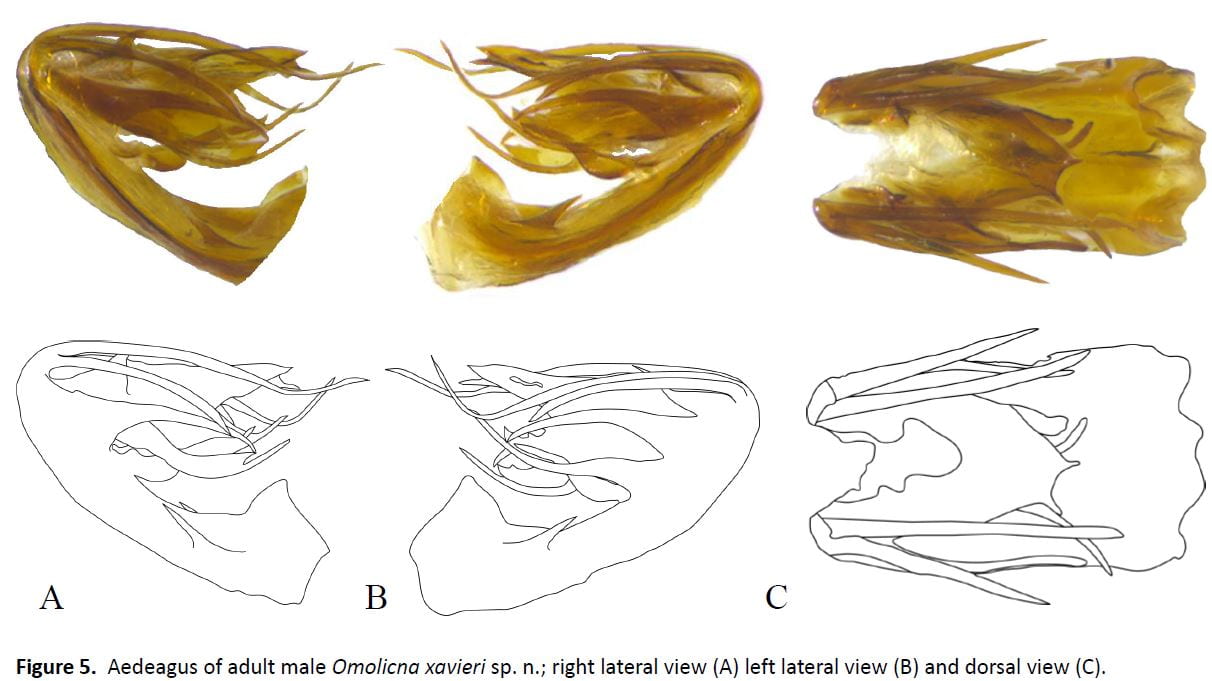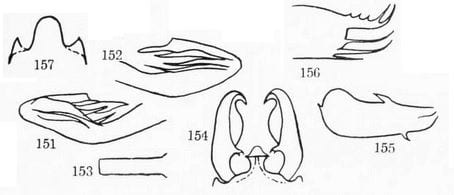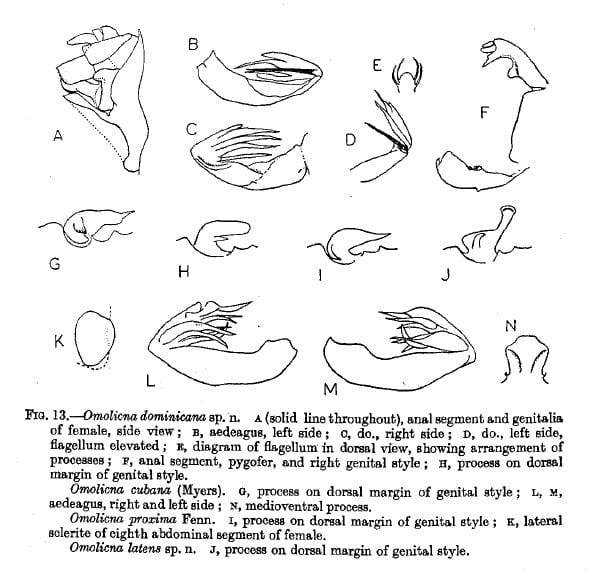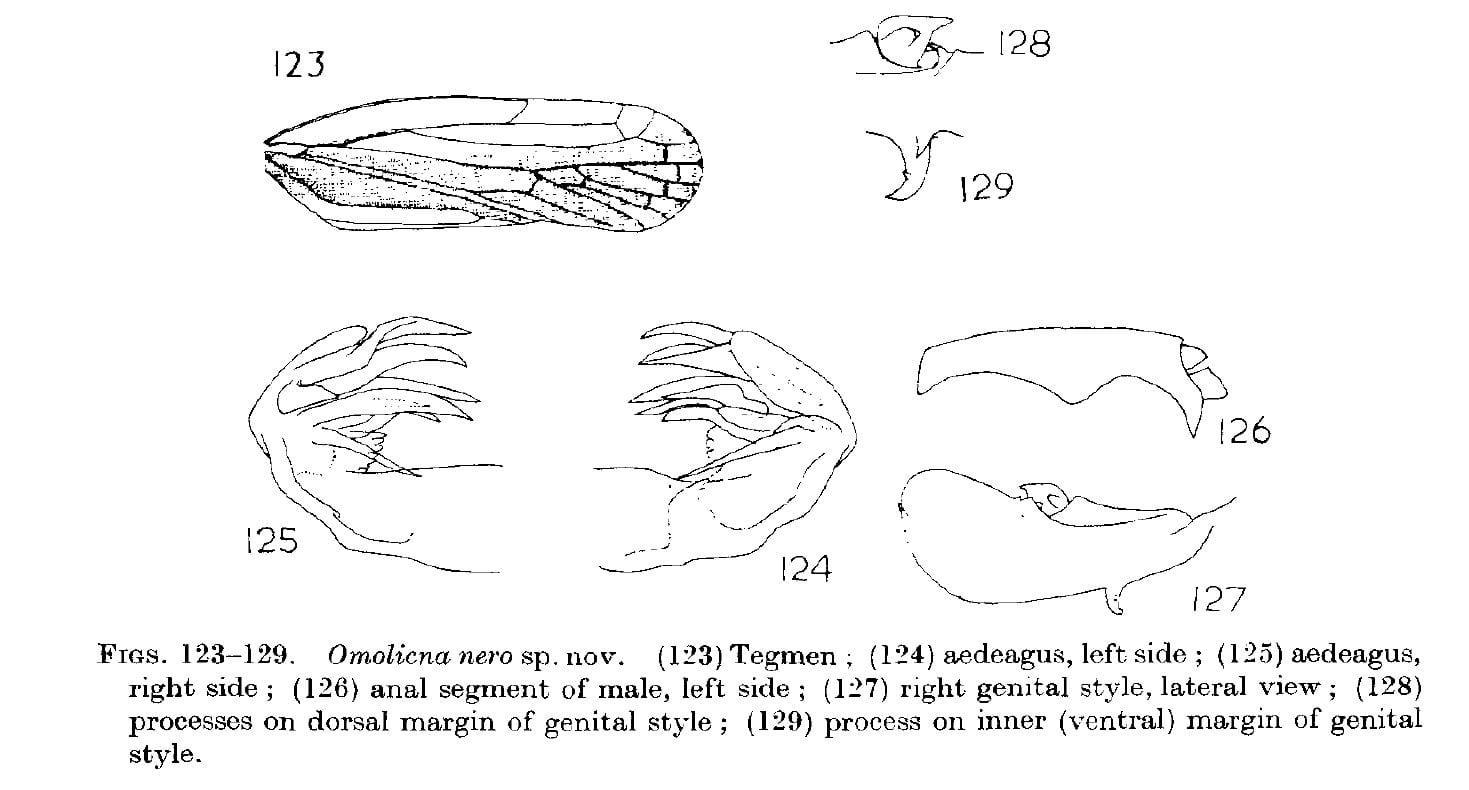[back to Classification of the Derbidae]
[back to North American Derbidae]
Contents
- 1 Family Derbidae Spinola, 1839
- 1.0.1 Subfamily Derbinae Spinola, 1839
- 1.0.2 Tribe Cenchreini Muir, 1917
- 1.0.3 Genus: Omolicna Fennah, 1945: 440.
- 1.0.4 Distribution
- 1.0.5 Recognized species
- 1.0.6 Economic Importance
- 1.0.7 Plant associations
- 1.0.8 Recognition
- 1.0.9 Online resources
- 1.0.10 Collecting
- 1.0.11 Molecular resources
- 1.0.12 Selected references
Family Derbidae Spinola, 1839
Subfamily Derbinae Spinola, 1839
Tribe Cenchreini Muir, 1917
Genus: Omolicna Fennah, 1945: 440.
Type species: Omolicna proxima Fennah, 1945: 440.
Subgenus
The subgenus Agoo Bahder & Bartlett, 2019 contains (for now) the species Omolicna (Agoo) xavieri Bahder & Bartlett, 2019. All other species are in the subgenus Omolicna.
**Bahder et al. (2020) gave Agoo the new status of a full genus.
Synonyms
Phaciocephalus Kirkaldy, 1906: 428 (in part; type species Phaciocephalus vitiensis Kirkaldy 1906: 428); Caldwell 1951: 201 (in Caldwell & Martorell 1951), also Fennah 1952: 126. (Caldwell and Martorell 1951 specified only the ‘uhleri group’)
Distribution
Nearctic (especially southeast) and Neotropics.
Distribution of Omolicna from FLOW (13 Jan. 2020)
Recognized species
There are five species in the genus in the US (Omolicna nigripennis gets into Texas) plus 17 Neotropical species. All species except O. xavieri are in the subgenus Omolicna.
Nearctic species
Omolicna joi Wilson, Halbert and Bexine (in Halbert et al. 2014) – USA: FL
Omolicna mcateei (Dozier, 1928) [Metcalf 1945: 102] – USA: FL, GA, MS, NC, TN
= Cenchrea mcateei Dozier, 1928: 128.
= Syntames mcateei (Dozier, 1928); comb. by Metcalf 1938: 328, 329
= Phaciocephalus mcateei (Dozier, 1928); comb. by Caldwell 1944b: 102.
= Phaciocephalus nicatiei (Dozier, 1928); missp. by Wray 1967: 30
= Omolicna mcateei (Dozier, 1928); comb. by implication Caldwell & Martorell 1951: 201; also O’Brien 1982b: 320.
Omolicna texana (Caldwell, 1944b) – USA: TX
=Phaciocephalus texanus Caldwell, 1944b: 103.
= Omolicna texana (Caldwell, 1944b); comb. by implication Caldwell & Martorell 1951: 201; emendation by O’Brien 1982b: 320.
Omolicna uhleri (Ball, 1902b) [Metcalf 1945: 103] – USA: AL, DC, GA, IL, KS, MD, MO, MS, NC, NJ, NY, OH, TN, VA; CAN: ON
= Cenchrea uhleri Ball, 1902b: 261
= Phaciocephalus uhleri (Ball, 1902b); comb. by Muir 1918a: 418
= Lamenia uhleri (Ball, 1902b); comb. by Smith 1910.
= Syntames uhleri (Ball, 1902b); comb. by Fennah 1952: 136.
= Omolicna uhleri (Ball, 1902b); comb. by implication Caldwell & Martorell 1951: 201; also O’Brien 1982b: 320.
Neotropical species (see O’Brien 1982)
Omolicna anastomosus (Caldwell 1944: 104) – Guatemala
= Phaciocephalus anastomosus Caldwell 1944: 104.
= Omolicna anastomosus (Caldwell 1944); comb. by implication Caldwell & Martorell, 1951: 200.
Omolicna brunnea (McAtee 1924: 178) – Costa Rica, Mexico (Veracruz), Panama, Guatemala
Omolicna cubana (Myers, 1926) – Jamaica, Cuba, Puerto Rico
=Lamenia uhleri (Van Duzee, 1907) non Ball, 1902
Omolicna dominicana Fennah 1952: 135 – Dominica
*Omolicna dubia (Caldwell 1944: 105) – Mexico (Chiapas) (moved to Anchimothon Fennah by Bahder et al 2020)
Omolicna fulva (Van Duzee 1909: 195) – Cuba, Panama, USA: Florida (listed above under Nearctic species)
Omolicna latens Fennah, 1952: 136 – Trinidad
Omolicna mariajosae Bahder & Bartlett, 2021 – Costa Rica
Omolicna nero Fennah 1971: 327 – Cayman Is. (Grand Cayman)
Omolicna nigripennis (Caldwell 1944: 103) – Mexico (Chiapas, Michoacán, San Luis Potosi, Veracruz)
Omolicna nigripennis var. flavipennis (Caldwell 1944: 104) – USA: TX; Mexico (Chiapas, Oaxaca, San Luis Potosí, Sinaloa, Veracruz); Guatemala
Omolicna proxima Fennah 1945: 441 – Trinidad, Venezuela
Omolicna puertana Caldwell, 1951: 201 (in Caldwell & Martorell 1951) – Puerto Rico
Omolicna puncta (Caldwell 1944: 104) – Mexico
Omolicna quadrispinosa (Caldwell 1944: 103) – Mexico (Chiapas)
Omolicna tarco Fennah 1971: 325 – Cayman Is. (Cayman Brac)
Omolicna triata (Caldwell 1944: 104) – Belize, Costa Rica
Agoo Bahder & Bartlett, 2019 (Type species Omolicna (Agoo) xavieri Bahder & Bartlett, 2019)
Agoo argutiola Bahder & Bartlett, 2020 – Brazil
Agoo beani Bahder & Bartlett, 2020 – Jamaica
Agoo cocoana Rodríguez-León & González 2005 – Cuba
=Omolicna cocoana Rodríguez-León & González 2005: 138
Agoo dahliana Bahder & Bartlett, 2020 – Costa Rica
Agoo fulvus (Van Duzee, 1909) [Metcalf 1945: 102] – USA: FL; Cuba; Panama.
= Cenchrea fulva Van Duzee, 1909: 195
= Phaciocephalus fulvus (Van Duzee, 1909); comb. by Myers 1926: 91, 103; also Fennah 1952: 136.
= Syntames fulvus (Van Duzee, 1909); comb. by Metcalf 1938: 328.
= Omolicna fulvus (Van Duzee, 1909); comb. by implication Fennah 1952: 136; also Wilson & McPherson 1980b: 13.
= Omolicna fulva (Van Duzee, 1909); emendation by O’Brien 1982b: 320.
Agoo galbina Cantanhede, Viegas & Ale-Rocha, 2024 – Brazil
Agoo keili Bahder & Bartlett, 2025 – Costa Rica
Agoo kizini Pinedo-Escatel & Blanco-Rodríguez, 2025 – Mexico (Yucatán, Quintana Roo).
Agoo luzdenia Bahder & Bartlett, 2020 – Costa Rica
Agoo palmalopezi Pinedo-Escatel & Blanco-Rodríguez, 2025 – Mexico (Tabasco).
Agoo rubrimarginatus (Fennah, 1945) – Trinidad
= Omolicna rubrimarginata Fennah, 1945: 442 – Trinidad
Agoo spina Bahder & Bartlett, 2020 – Brazil
Agoo xavieri (Bahder & Bartlett, 2019) – Costa Rica
Economic Importance
Omolicna joi is a potential vector of palm lethal yellows or Texas Phoenix Palm Decline. Omolicna xavieri, O. brunnea, O. triata and O. puertana have all been collected from palms and may also vector phytoplasmas (e.g., Segarra-Carmona et al. 2013, Bahder et al. 2019). Omolicna cocoana from Cuba was described from palms.
Plant associations
Omolicna cocoana – Coccothrinax litoralis León (Arecales, Arecaceae) (Rodriguez-Leon & Hidalgo- Gato 2005: 138)
Omolicna joi – Sabal palmetto (Walter) Lodd. ex Schult. & Schult. f. (Cabbage palmetto) and Serenoa repens (W. Bartram) Small (Saw palmetto) (both Arecaceae)
Omolicna mcateei – Physalis L. (groundcherry, Solanaceae)
Omolicna puertana – Carica papaya L. (papaya, Caricaceae), Solanum melongena L. (eggplant, Solanaceae), Melia azedarach L. (Chinaberrytree, Meliaceae) (Caldwell & Martorell 1951: 202)
Omolicna sp. – Pritchardia thurstonii F. Muell. & Drude, Cocos nucifera L. (coconut palm), Roystonea hispaniolana L.H. Bailey, Sabal umbraculifera Mart. (Arecaceae), Veitchia merrillii (Becc.) H.E. Moore (all Arecaceae)
Omolicna xavieri – Coconut palm (Cocos nucifera L.), Arecaceae
Hosts from Wilson et al. 1994 and Halbert et al 2014; plant names from USDA PLANTS or Tropicos.
Recognition
Pale (usually orangish, not grey to black as most Cedusa), robust; frons compressed but not extremely; pustules along claval vein; Media with more than two branches, connected to cubitus by crossvein; size less than 6 mm; projections of pronotum partially subtending antennae.
Description of the genus from Fennah 1945: 441:
Vertex broad, depressed along middle, lateral margins converging apically, apical margin straight or slightly concave, posterior margin shallowly excavated, width across base greater than length down middle, two rows of sensoria on raised area near each lateral margin; frons longer than wide at apex (about 2 to 1), width at apex approximately one and one-half times width at base, lateral margins diverging gradually to apex, devoid of granules, median carina absent, usually a longitudinal depression down middle of frons, a series of sensory pits inside each lateral margin; frontoclypeal suture impressed, clypeus slightly tumid with a median carina; genae devoid of a subantennal process. Pronotum with antennal foveae large. Tegmina long, parallel sided, Sc + R + M fork at basal quarter, Sc+R fork between basal third and middle of costal margin, subcostal cell long, M forking about level with apex of clavus, Cu1 forking level or slightly distad of junction of claval veins, M with five veins reaching apical margin, three arising from a discal cell. “Wings with R and M simple to apex, linked by a transverse vein four-fifths from base, Cu1a forked just basad of its midpoint, where it is joined by a transverse vein from M, the limbs of the fork scarcely diverging to margin, Cu1b simple to apex, Cu2 simple. Anal segment of male narrow, tubular, pygofer with a simple pointed medioventral process, genital styles incurved at apex. Anal segment of female very short, pregenital sternite with a broad lobe at middle of posterior margin. Egg bluntly ovoid, smooth, transparent, twice as long as broad.
Genotype : Omolicna proxima new species [Fennah 1945].
This genus differs from Syntames Fowler in the absence of a median carina on the frons, from Cenchrea Westwood in the lower lateral carinae of the vertex and the tegminal and wing venation, and from Phaciocephalus Kirkaldy in tegminal and wing venation.
An amended description from Bahder et al 2019 is as follows
The members of this genus can be separated from similar cenchreine derbids by the relatively broad vertex with pit-like sensoria bordering the lateral margins (these pits were given as a tribal feature in Emeljanov (1995). Vertex wider than long (midline less than 2x as long as broad at widest part), medially concave, with the lateral margins diverging caudally. Frons moderately compressed, elongate, narrowed between eyes, without a longitudinal median carina, lateral margins foliately keeled. A scroll-like extension of the lateral aspect of the pronotum partially surrounds and subtends the base of the antennae forming antennal fossae (a tribal feature). Forewings with pits on postcubitus in clavus (a tribal feature), clavus closed (combined Pcu + A1 reaching CuP), extending beyond midlength of forewing. The male pygofer with a median ventral process, phallotheca (periandrium) with terminal flagellum (endosoma) folded anterodorsally with an asymmetrical arrangement of spines.
Agoo can often be separated from Omolicna by the much narrower face. The two genera also differ in the form of male terminalia. Agoo appears to be quite similar to Cenanges Fennah, 1952, from Dominica.
The recognition of species of Omolicna from the U.S. is problematic because the genitalia of O. mcateei & O. uhleri are not adequately described, and the types of O. mcateei appear to be lost. Halbert et al. (2014) present a key to Omolicna of Florida species as follows:
Key to species of Omolicna potentially in Florida
(From Halbert et al. 2014)
1. Forewing with dark brown stripe paralleling costal margin, costa pale; male pygofer median process spatulate, parameres with a serrate subtriangular process on inner margin; aedeagus with anteroventrally-directed curved spine originating from apex on the right side (see Caldwell 1944, fig. 1) … Omolicna uhleri (Ball)
1’. Forewing without dark brown stripe paralleling costal margin; costa concolorous … 2
2. Vertex not strongly elevated; male pygofer median process broadly rounded with a small tooth on each side (fig. 2e – included below), parameres with a serrate subtriangular process on inner margin (fig. 2f); aedeagus with anterodorsally-directed broad spine and a parallel slender spine originating from apex on the left side (fig 2a) … Omolicna joi Wilson, Halbert & Bexine, 2014
2’. Vertex strongly elevated; male pygofer median process with strong lateral tooth and small basal tooth on each side (see Caldwell 1944, fig. 2) or subtriangular … 3
3. Body pink; larger, 6.5 mm; male pygofer median process subtriangular … Omolicna fulva (Van Duzee)
3’. Body fulvous; smaller, 3.5-4.0 mm; male pygofer median process with strong lateral tooth and small basal tooth on each side … Omolicna mcateei (Dozier)

Omolicna spp. (all photographs and drawings – except as noted – by Kimberley Shropshire, University of Delaware)

Omolicna uhleri from Discover Life.

Omolicna uhleri (BOLD, CNC#HEM405591)
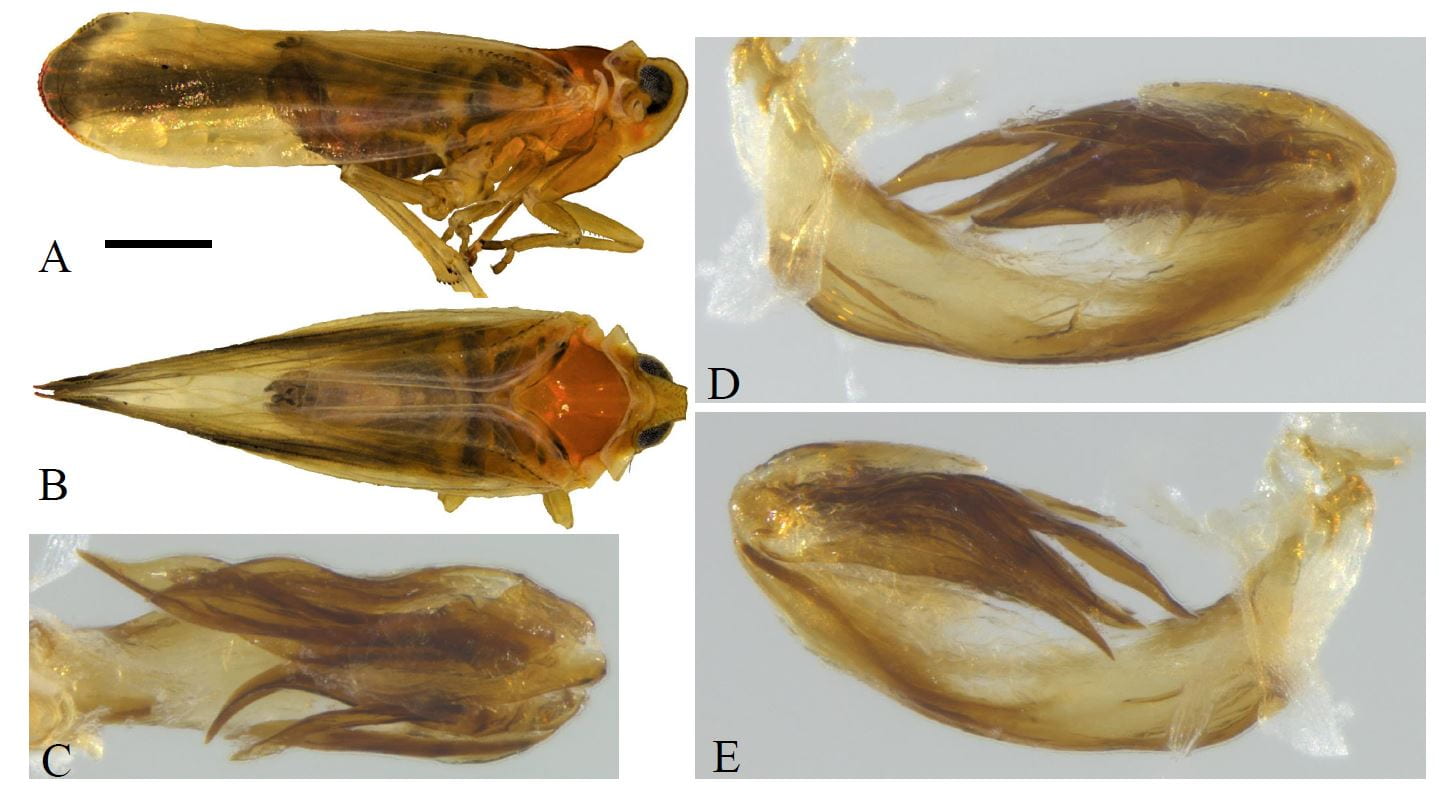
Adult male of Omolicna triata, scale bar=1mm; lateral view of body (A) dorsal view of body (B) dorsal view of aedeagus(C) left lateral view of aedeagus(D) and right lateral view of aedeagus(E).
Omolicna joi from Halbert et al. 2014

Caldwell 1944 Plate 2 A right side of aedeagus; B medio-ventral process of pygofer, C anal tube) 1. Omolicna uhleri 2. Omolicna mcateei 3. Omolicna texana 4. Omolicna triata 5. Omolicna nigripennis 6. Omolicna quadrispinosa 7. Omolicna anastomosa 8. Omolicna puncta 9. Omolicna dubia
Online resources
BugGuide.
FLOW.
EOL.
3i Taxonomic database.
BOLD.
GBIF.
Discover Life.
iNaturalist.
Collecting
Common – come so lights and often collected sweeping.
Molecular resources
Barcode of life has sequence data from 239 specimens representing nine species, but two of these (fulva & xavieri) are in Agoo. GenBank has data on nine species.
Selected references
Ball, E.D. 1902. New genera and species of North American Fulgoridae. Canadian Entomologist 34: 259–266.
Bahder, B.W., C.R. Bartlett, E.A.B. Barrantes, M.A.Z. Echavarria, A.R. Humphries, E.E. Helmick, M.S. Ascunce & E.M. Goss. 2019. A new species of Omolicna (Hemiptera: Auchenorrhyncha: Fulgoroidea: Derbidae) from coconut palm in Costa Rica and new country records for Omolicna brunnea and Omolicna triata. Zootaxa 4577 (3): 501–514. https://doi.org/10.11646/zootaxa.4577.3.5
Bahder, B.W., C.R. Bartlett, E.E. Helmick, E.A.B. Barrantes, M.A.Z. Echavarria, E,M, Goss & M.S. Ascunce. 2020. Revised status of Omolicna subgenus Agoo (Hemiptera: Auchenorrhyncha: Fulgoroidea: Derbidae) with a new species from Costa Rica and new country records. Zootaxa 4718(4): 521–535.
Bahder, B.W., Mou, D.-F., Bartlett, C.R., Helmick, E.E., Bertaccini, A. & Myrie, W. 2020. A new species of planthopper in the genus Agoo Bahder & Bartlett (Hemiptera: Fulgoroidea: Derbidae) from coconut palm (Cocos nucifera L.) in Jamaica. Zootaxa, 4853(2): 254–264. https://doi.org/10.11646/zootaxa.4853.2.6
Bahder, B.W., M.A.Z. Echavarria, E.A.B. Barrantes, G. Kunz, E.E. Helmick & C.R. Bartlett. 2020. A new species of planthopper in the genus Agoo (Hemiptera: Fulgoroidea: Derbidae) from coquito palms (Astrocaryum alatum) in Costa Rica. Zootaxa 4779(3): 409–418. https://doi.org/10.11646/zootaxa.4779.3.8
Barrantes, E.A.B., M.A.Z. Echavarria, C.R. Bartlett, E.E. Helmick & B.W. Bahder. 2025. Multi-local analysis supports the transfer of Omolicna fulva to the genus Agoo and establishment of a new species in the genus from Costa Rica. Zootaxa, 5584(1): 113–125. https://doi.org/10.11646/zootaxa.5584.1.7
Bartlett, C.R., L.B. O’Brien & S.W. Wilson. 2014. A review of the planthoppers (Hemiptera: Fulgoroidea) of the United States. Memoirs of the American Entomological Society 50: 1–287.
Benton, E.P. & J.W. McCreadie. 2009. A preliminary survey of the planthoppers (Hemiptera: Fulgoroidea) of coastal Alabama. Proceedings of the Entomological Society of Washington 111(2): 354–360.
Caldwell, J.S. 1944. The tribe Cenchreini with special references to the Cenchrea complex (Homoptera: Derbidae). Bulletin of the Brooklyn Entomological Society 39: 99–110.
Caldwell, J.S. & L.F. Martorell. 1951 [dated 1950]. Review of the Auchenorynchous [sic] Homoptera of Puerto Rico. Part II. The Fulgoroidea except Kinnaridae. Journal of Agriculture of the University of Puerto Rico 34(2): 133–269.
Cantanhede, I., Viegas, E.F.G. & Ale-Rocha, R. 2024. The first record of Agoo Bahder & Bartlett, 2019 (Hemiptera: Fulgoroidea: Derbidae) for the state of Amazonas, Brazil, with the description of a new species. Entomological Communications, 6, 1–4. https://doi.org/10.37486/2675-1305.ec06036
Dollet, M., Fidelis, E.G., dos Passos, E.M., da Silva, F.G., Aberlenc, H.-P., Schurt, D.A., Bahder, B.W., Diniz, L.E.C. & Bartlett, C.R. 2020. Derbid planthoppers (Hemiptera: Fulgoroidea: Derbidae) associated with coconut and oil palm in Brazil. Neotropical Entomology, 49, 722–738. https://doi.org/10.1007/s13744-020-00788-5
Dozier, H.L. 1928 [dated 1922 or 1926]. The Fulgoridae or planthoppers of Mississippi, including those of possible occurrence. Technical Bulletin of the Mississippi Agricultural Experiment Station 14: 1–152.
Echavarria, M.A.Z., E.A.B. Barrantes, C.R. Bartlett, E.E. Helmick & B.W. Bahder. 2021. A new planthopper species in the genus Omolicna (Hemiptera: Auchenorrhyncha: Derbidae) from the Reserva Privada el Silencio de Los Angeles Cloud Forest in Costa Rica. Zootaxa 4975(2): 357–368.
Emeljanov, A.F. 1995. On the problem of a system and a phylogeny of the family Derbidae (Homoptera, Cicadina). Entomologicheskoe Obozrenie 73(4): 783–811 & 946–947. [Russian] [English Translation: Entomological Review 75(2): 70–100]
Fennah, R.G. 1945. The Fulgoroidea, or lanternflies, of Trinidad and adjacent parts of South America. Proceedings of the United States National Museum 95(3184): 411–520.
Fennah, R.G. 1952. On the generic classification of Derbidae (Fulgoroidea), with descriptions of new Neotropical species. Transactions of the Royal Entomological Society of London 103(4): 109–170.
Fennah, R.G. 1971. Fulgoroidea from the Cayman Islands and adjacent Areas. Journal of Natural History 5: 299–342.
Gonzon, A. T., Jr., C. R. Bartlett and J. L. Bowman. 2007 (dated 2006). Planthopper (Hemiptera: Fulgoroidea) diversity in the Great Smoky Mountains National Park. Transactions of the American Entomological Society 132: 243–260.
Halbert, S.E., S.W.Wilson, B. Bextine & S.B. Youngblood. 2014. Potential planthopper vectors of palm phytoplasmas in Florida with a description of a new species of the genus Omolicna (Hemiptera: Fulgoroidea). Florida Entomologist 97(1): 90–97.
Kirkaldy, G. W. 1906c. Leafhoppers and their natural enemies. (Pt. IX Leafhoppers. Hemiptera). Bulletin. Hawaiian Sugar Planters’ Association Experiment Station. Division of Entomology 1(9): 271–479.
McAtee, W. L. 1924. Notes on Cenchrea Westwood and Cedusa Fowler in America (Homoptera: Fulgoroidea). Annals of the Entomological Society of America 17: 175–187.
Metcalf, Z.P. 1938. The Fulgorina of Barro Colorado and other parts of Panama. Bulletin of the Museum of Comparative Zoology, Harvard Collections. 82: 277–423.
Metcalf, Z.P. 1945. Fulgoroidea (Homoptera) of Kartabo, Bartica District, British Guiana. Zoologica. Scientific Contributions of the New York Zoological Society 30: 125–144.
Metcalf, Z.P. 1945. General Catalogue of the Hemiptera. Fascicle IV, Fulgoroidea, Part 4, Derbidae. Smith College, Northhampton, Massachusetts. [species in Phaciocephalus or Syntames]
Muir, F.A.G. 1917. The Derbidae of the Philippine Islands. Philippine Journal of Science 12: 49–105.
Muir, F.A.G. 1918 (dated 1917). Homopterous notes II. Proceedings of the Hawaiian Entomological Society 3: 414–429.
Nixon, P.L. & J.E. McPherson. 1977. An annotated list of the phytophagous insects collected on immature black walnut trees in southern Illinois. Great Lakes Entomologist 10: 211-222.
O’Brien, L.B. 1982. Two Neotropical derbid genera with observations on wing rolling (Fulgoroidea: Homoptera). Florida Entomologist 65(3): 306–321.
Paiero, S.M., S.A. Marshall & K.G.A. Hamilton. 2003. New records of Hemiptera from Canada and Ontario. Journal of the Entomological Society of Ontario 134: 115–129.
Palma Cancino, P., J.A. Pinedo-Escatel, E. Blanco-Rodríguez, B.W. Bahder & C. Ortiz. 2025. Two new species of the palm-feeding planthopper genus Agoo (Hemiptera: Fulgoroidea: Derbidae) from southern Mexico. Zootaxa 5706, 279–291. https://doi.org/10.11646/zootaxa.5706.2.8
Rodríguez-León Merino, R. & M.M. Hidalgo-Gato González. 2005. Descripción de una cueva especie de Omolicna Fennah, 1945 (Hemiptera: Derbidae) de Cuba. Boletín de la SEA (Sociedad Entomológica Aragonesa) 37: 137–139.
Segarra-Carmona, A., R.A. Franqui & M. Otero-Arocho. 2013. Survey of palm-associated Fulgoroidea in Puerto Rico. Journal of Agriculture of the University of Puerto Rico 97(3-4): 107–117.
Smith, J.B. 1910a. Order Homoptera. Pp. 87-130. In: A report of the insects of New Jersey. Annual Report of the New Jersey State Museum 1909: 1–888. (PDF only to end of Auchenorrhyncha, p. 107; see link to BHL for whole volume) (see p. 94–98)
Spinola, M. 1839. Essai sur les Fulgorelles, sous-tribu de la tribu des Cicadaires, ordre des Rhyngotes. Annales de la Société Entomologique de France 8: 133–337.
Van Duzee, E.P. 1909. Observation of some Hemiptera taken in Florida in the spring of 1908. Bulletin of the Buffalo Society of Natural Sciences 9: 149–230.
Weber, B.C. & S.W. Wilson. 1981. Seasonal and vertical distributions of planthoppers (Homoptera: Fulgoroidea) within a black walnut plantation. Great Lakes Entomologist 14(2): 71–75.
Wilson, S.W. & J.E. McPherson. 1980a. Keys to the planthoppers, or Fulgoroidea, of Illinois (Homoptera). Transactions of the Illinois Academy of Science 73(2): 1–61.
Wilson, S.W. & J.E. McPherson. 1980b. The distribution of the Fulgoroidea of the eastern United States (Homoptera). Transactions of the Illinois Academy of Science 73(4): 7–20.
Wilson, S.W. & J.E. McPherson. 1980c. A list of the Fulgoroidea (Homoptera) of southern Illinois. Great Lakes Entomologist 13(1): 25–30.
Wilson, S.W., J.L. Smith & P.D. Calvert. 1993. Planthoppers of a Missouri tallgrass prairie (Homoptera: Fulgoroidea). Journal of the Kansas Entomological Society 66: 75–80.
Wilson, S.W., C. Mitter, R.F. Denno & M.R. Wilson. 1994. Evolutionary patterns of host plant use by delphacid planthoppers and their relatives. In: R.F. Denno & T.J. Perfect (eds.). Planthoppers: Their Ecology and Management. Chapman and Hall, New York. Pp. 7–45 & Appendix.
Wray, D.L. 1967. Insects of North Carolina, Third supplement. North Carolina Department of Agriculture, Raleigh, North Carolina.

